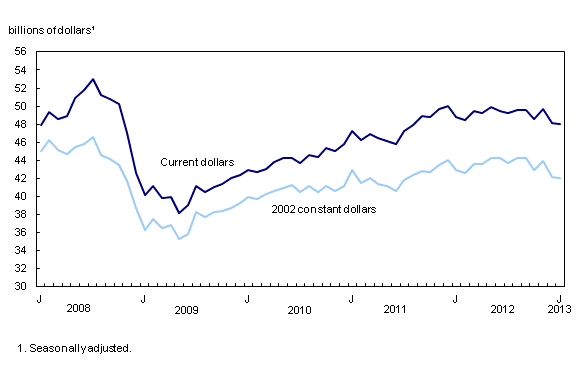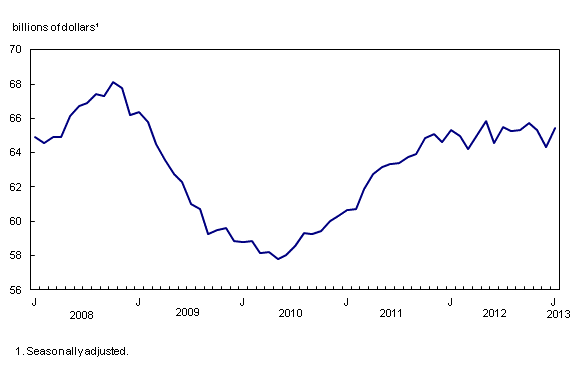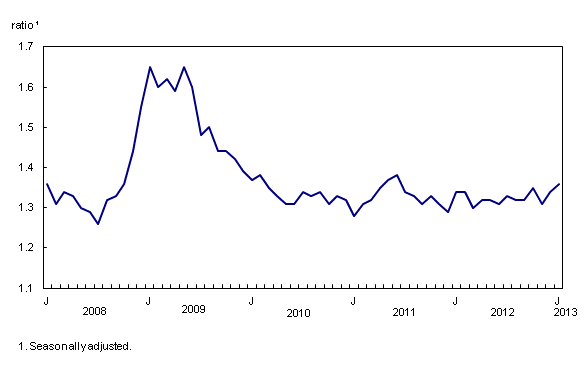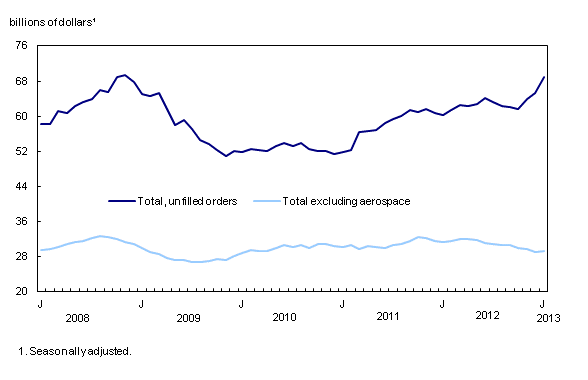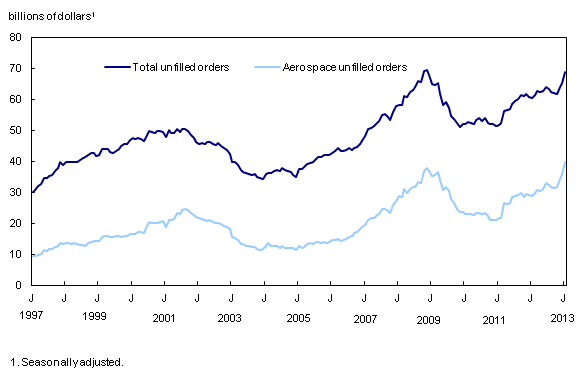Monthly Survey of Manufacturing, January 2013
Archived Content
Information identified as archived is provided for reference, research or recordkeeping purposes. It is not subject to the Government of Canada Web Standards and has not been altered or updated since it was archived. Please "contact us" to request a format other than those available.
Released: 2013-03-19
Manufacturing sales edged down 0.2% in January to $48.0 billion, the fourth decline in five months. Sales in January were down in the transportation equipment industry as well as the petroleum and coal product industry. Overall, 7 of 21 industries posted lower sales in January, representing approximately 52% of the manufacturing sector.
Durable goods sales declined 0.7% to $24.1 billion, while non-durable goods sales rose 0.3% to $23.9 billion.
Constant dollar sales fell 0.4% in January, indicating that the decline in manufactured goods sold was a result of lower volumes.
Unfilled orders increased 5.8% to $69.0 billion in January, the highest level since November 2008 ($69.3 billion). The gain stemmed almost entirely from higher unfilled orders in the aerospace product and parts industry. Unfilled orders are a stock of orders that will contribute to future sales assuming that they are not cancelled.
Sales decline in the transportation equipment industry
Sales declined 3.8% to $7.5 billion in the transportation equipment industry. The decrease mostly reflected a 19.7% drop in production in the aerospace product and parts industry. The aerospace industry is one of the more volatile industries in the manufacturing sector. A 3.7% decline in the motor vehicle assembly industry also contributed to the decrease in transportation equipment sales.
Petroleum and coal product sales decreased 1.8% to $7.0 billion in January. The decline mostly reflected lower sales volumes.
Sales in the food industry were down 1.3% to $6.7 billion, the fourth decline in five months. The level in January was the lowest since September 2010.
Sales down in four provinces
Manufacturing sales decreased in Quebec, Ontario, New Brunswick and Saskatchewan.
In Quebec, sales declined 2.7% to $11.3 billion, the largest decline since July 2012. The decrease was primarily caused by lower production in the aerospace product and parts industry.
Manufacturing sales in Ontario were down 0.8% to $21.6 billion. The decrease reflected a 3.2% decline in the motor vehicle assembly industry and a 5.9% drop in the petroleum and coal product industry.
Sales in New Brunswick dropped 6.7% to $1.6 billion, primarily as a result of lower sales in the non-durable goods industries.
In Saskatchewan, sales were down 4.9% to $1.1 billion, mostly because of declines in the durable goods industries.
In Alberta, sales rose 6.3% to $6.3 billion, the largest increase since November 2011. The gain was a result of increases in the petroleum and coal product (+7.6%), chemical (+11.0%) and machinery (+17.2%) industries. The gain in the machinery industry reflected higher sales of oil and gas field equipment.
Inventories rise
Inventory levels were up 1.7% to $65.4 billion in January. The gains were led by the aerospace product and parts, and primary metal industries.
In the aerospace product and parts industry, inventories were up 4.1% to $5.0 billion, with two-thirds of the gain stemming from higher goods-in-process inventories while the remainder was caused by increased finished product inventories.
Primary metal inventories were up 2.4% to $7.7 billion, as a result of higher volumes held by manufacturers rather than price changes.
Inventories were also up in the petroleum and coal (+2.6%), fabricated metal (+2.3%), and the electrical equipment (+9.1%) industries.
The inventory-to-sales ratio rose from 1.34 to 1.36 in January, the highest level since June 2011.
Substantial gains in new and unfilled orders
In January, new orders increased 5.1% to $51.8 billion. Most of the gain was attributable to increases in the aerospace product and parts and machinery industries.
Unfilled orders rose 5.8% to $69.0 billion in January. The increase was almost entirely caused by a gain in the aerospace product and parts industry.
In the aerospace product and parts industry, unfilled orders rose 10.0% to a record high of $39.6 billion. The gain in January was the fourth consecutive monthly increase. Since September 2012, unfilled orders in the aerospace industry have advanced 26.2%.
Unfilled orders were up 2.6% to $7.2 billion in the machinery industry. The gain followed seven months of declines.
Manufacturing at a glance: Unfilled orders
Between January 1997 and January 2013, total unfilled orders rose from $30.1 billion to $69.0 billion, while sales during the same period increased from $34.8 billion to $48.0 billion. Hence, unfilled orders rose by 128.9% compared with a 38.0% increase in sales. Unfilled orders represent the backlog of orders held by a company at a particular point in time that will contribute to future sales, assuming orders are not cancelled.
On average, 96.0% of unfilled orders are concentrated in industries which manufacture durable goods. Between January 1997 and January 2013, unfilled orders in transportation equipment increased from $15.4 billion to $45.8 billion, and on average accounted for 57.5% of total orders. Over the same period, the aerospace product and parts industry was the largest contributor among all manufacturing industries and accounted for 73.5% of the unfilled orders in the transportation equipment industry.
Other industries which held a sizeable share of total unfilled orders included machinery manufacturing, fabricated metal products and computer and electronic products manufacturing. From January 1997 to January 2013, these three industries contributed an average of 13.1%, 8.7% and 7.1% to total unfilled orders respectively.
The effect of recent economic downturns on unfilled orders
Directly preceding the economic downturn of 2008 and 2009, total unfilled orders peaked at $69.3 billion in November 2008. Over the course of the next year, unfilled orders decreased sharply to $51.0 billion by November 2009. In comparison, during the economic downturn in 2001 and 2002, total unfilled orders decreased from $50.3 billion in July 2001 to $34.3 billion in December 2003, representing a 31.9% decrease over 29 months. However, this decline was more gradual than the recent decrease in unfilled orders, which fell 26.5% over 12 months.
Despite differences in the duration of the decline in unfilled orders, there was a noticeable parallel in the months following each of these economic events. In both cases, total unfilled orders maintained a consistent level for approximately one year before beginning to increase. After decreasing to a low of $34.3 billion in December 2003, total unfilled orders maintained an average level of $36.3 billion before beginning to consistently increase starting in January 2005. Similarly, after reaching a low of $51.0 billion in November 2009, total unfilled orders maintained an average level of approximately $52.4 billion before beginning to rise starting in January 2011.
After unfilled orders reached their cyclical low of $34.3 billion in December 2003 it took 38 months for them to reach their previous high of $50.3 billion. In the current business cycle, 38 months have also passed since unfilled orders reached their cyclical low of $51.0 billion. At approximately $400 million short of their highest level, unfilled orders are again displaying similar patterns in recovery.
Note to readers
Monthly data in this release are seasonally adjusted and are expressed in current dollars unless otherwise specified. Preliminary data are provided for the current reference month. Revised data, based on late responses, are updated for the three previous months.
Non-durable goods industries include food, beverage and tobacco products, textile mills, textile product mills, clothing, leather and allied products, paper, printing and related support activities, petroleum and coal products, chemicals, and plastics and rubber products.
Durable goods industries include wood products, non-metallic mineral products, primary metal, fabricated metal products, machinery, computer and electronic products, electrical equipment, appliances and components, transportation equipment, furniture and related products and miscellaneous manufacturing.
Production-based industries
For the aerospace industry and shipbuilding industries, the value of production is used instead of sales of goods manufactured. This value is calculated by adjusting monthly sales of goods manufactured by the monthly change in inventories of goods in process and finished products manufactured.
Unfilled orders are a stock of orders that will contribute to future sales assuming that the orders are not cancelled.
New orders are those received whether sold in the current month or not. New orders are measured as the sum of sales for the current month plus the change in unfilled orders from the previous month to the current month.
Data from the February Monthly Survey of Manufacturing will be released on April 16.
Contact information
For more information, contact us (toll-free 1-800-263-1136; infostats@statcan.gc.ca).
To enquire about the concepts, methods or data quality of this release, contact Michael Schimpf (613-951-9832; michael.schimpf@statcan.gc.ca), Manufacturing and Energy Division.
- Date modified:


